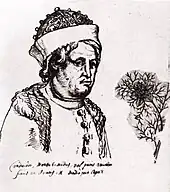Levan II Dadiani
Levan II Dadiani (also Leon; Georgian: ლევან [ლეონ] II დადიანი; 1597-1657) was a member of the House of Dadiani and ruler of the Principality of Mingrelia in western Georgia. Levan is known for his extensive raiding of neighboring countries and taking hostages for ransom.
| Levan II Dadiani | |
|---|---|
 Fresco of Levan II | |
| Prince of Mingrelia | |
| Reign | 1611-1657 |
| Predecessor | Manuchar I Dadiani |
| Successor | Liparit III Dadiani |
| Born | 1597 |
| Died | 1657 |
| Spouse | Tamunia Shervashidze Darejan Chiladze |
| Dynasty | House of Dadiani |
| Father | Manuchar I Dadiani |
| Religion | Georgian Orthodox Church |
| Khelrtva | .svg.png.webp) |
Biography
Levan grew up in Kakheti under his grandfather King Alexander II, but at the age of fourteen became prince of Mingrelia when his father Manuchar I fell from a horse and died while hunting. Initially, Levan ruled under the regency of his uncle, Giorgi I Lipartiani. [1][2]
In the 1620s, Levan allied with the Principality of Abkhazia and Principality of Guria against George III of Imeretia after George's son Alexander accused his wife Tamar of adultery and divorced her, sending her back to her father, Mamia II Gurieli. The alliance was further cemented when Levan's sister Mariam married Mamia's son Simon and Levan married Seteman Sharvashidze's daughter Tamunia.[3] However, the alliance was shattered when Levan accused Tamunia of adultery, cut off her ears and nose and cast her from Mingrelia. He then invaded and looted Abkhazia, poisoned his two sons by Tamunia, then abducted and married Darejan Chiladze, the wife of his uncle and former regent, Giorgi I Lipartiani. He then repeatedly raided Imeretia and Abkhazia, confiscating livestock. While a common practice amongst the Mongols and Seljuks, Levan was the first to in the Caucausus to extensively take hostages for ransom, making raiding a profitable venture.[4] [2]
When Simon murdered his father and ascended to the Gurian throne in 1625, Levan demanded his sister back. Instead, Simon released Levan Dadiani's disgraced vizier Paata "Tsutski" Tsulukidze, who had been handed by Dadiani to Mamia Gurieli for custody. Tsulukidze and Gurieli plotted Levan's murder, but Dadiani survived their Abkhaz assassin and had Tsulukidze strangled and quartered, firing the remains from a cannon. Thereafter, he exploited the patricide committed by Simon as a casus belli and invaded Guria. Simon resisted, but was defeated at Lanchkhuti and taken prisoner. Levan had him blinded and replaced with Kaikhosro I Gurieli, the son of Vakhtang I Gurieli. Simon's wife and son were taken to Mingrelia.[4][5]
Levan allied with Sultan Murad IV of the Ottoman Empire trading Turkish cavalry for smelted iron, slaves and wool.[6]
In 1633, he allied to Rostom of Kartli, who married his sister Mariam. The alliance pleased the Persian shah Safi, who sent 1.5 tons of silver as a wedding present. George III of Imereti attempted to intercept Levan on his way to the marriage, but was defeated and taken prisoner.[3]
In 1646 he destroyed the walls of Kutaisi with cannon fire and plundered the country. He blinded Prince Mamuka of Imereti, who had been planned as the future king to unite Georgia, for resisting his actions. This prompted King Rostom of Kartli to solemnly curse him.[7] [2] George III's successor, Alexander III took an oath of fealty to Tsar Alexis of Russia in hopes of ending Levan's devastation. However the Russian were still too far from South Caucasus and this move had virtually no effect on the course of events.[2][7]

Throughout Levan's forty-six year reign he was known for practicing various forms of barbarity, mutilation and torture. He normalized the practice of holding prisoners for ransom, making war more profitable among warlords in western Georgia. He also encouraged commerce from foreign merchants and was known as a competent administrator. He spurred the practice of goldsmithing and used large amounts of wealth for the decoration of churches and monuments.[8]
In March 1657, while despairing over his remaining son's corpse, he struck himself with a staff and dropped dead. He would be succeeded by his nephew Liparit III.[9]
Notes
- Rayfield 2012, p. 189.
- Suny 1994, p. 51.
- Rayfield 2012, p. 194.
- Rayfield 2012, pp. 194–195.
- Khakhutaishvili 2009, pp. 45–46.
- Rayfield 2012, p. 195.
- Rayfield 2012, p. 208.
- Rayfield 2012, pp. 207–213.
- Rayfield 2012, p. 213.
References
- Khakhutaishvili, Davit (2009). "ნარკვევები გურიის სამთავროს ისტორიიდან (XV-XVIII სს.)" [Studies in the history of the Principality of Guria (15th–18th centuries)]. სამტომეული, ტ. 2 [Works in three volumes, Vol. 2] (in Georgian). Batumi: Shota Rustaveli State University. pp. 45–46. ISBN 978-9941-409-60-8.
- Rayfield, Donald (2012). Edge of Empires (Kindle ed.). London: Reaktion Books.
- Suny, Ronald Grigor (1994). The Making of a Georgian Nation (2nd ed.). Indianapolis: Indiana University Press.